
14-08-2015 01:00
Bonjour ! Je viens d'étudier Pulvinula carbonari

14-08-2015 10:13
estas pequeñas setas, a las que no he apreci

22-08-2014 18:01
 Bernard Declercq
Bernard Declercq
Hallo to everybody,Does anyone have following docu

13-08-2015 21:51
 Andreas Gminder
Andreas Gminder
Hello to all - especially Zotto ;-) an Orbilia wi

13-08-2015 20:31
 Maren Kamke
Maren Kamke
Hi everybody,I found on old Phragmites detritus a

13-08-2015 21:07
 Andreas Gminder
Andreas Gminder
Hello, a Lachnum from today with crystal druses o

13-08-2015 19:55
 Andreas Gminder
Andreas Gminder
Chers collègues, aujourd'hui Tanja a trouvé Hyp

12-08-2015 21:20
Hi to everyone This superficial, globose, finely
this species was found on a small branch of a decidious tree on the ground. I am not sure which Trichophaeopsis species this could be with such ascospores - they have no content, measure about 18,0-19,1 x 10,3-12,0 µm and have a sheath around them. Asci are 8-spored. Any ideas?
Thank you and best wishes,
Gernot
This is most likely Trichophaeopsis bicuspis.
A sheath around the spores can occur but usually disappears after a while. The invisibility of oil drops - mostly two small clusters or big ones near the poles - can be caused by the presence of the sheath.
I found this species several times on debris, leafs, twigs, branches and wood of Populus. Also on bare soil with Populus nearby.
Best wishes,
Ron
thanks for your response! I find it very interesting that the visibility of the content of the ascosospores can be influenced by the presence of a sheath. I was a bit unsure whether it could actually be T. bicuspis since I have never found this species before and its ascospores are usually illustrated and described as having a few oil drops.
Populus could be a good guess - according to the person who found it there are a lot of Populus trees around in the area where she found this fungus.
Best wishes and thanks again,
Gernot
I have studied several living collections of this beautiful species and the spore size can range from (14)15-18(20) x 9-12 ?m.
The absence or should we say invisibility of oil drops is indeed remarkable and I also never observed this in my material.
But there are other mycologists who did.
Kanouse (1958) described the spores of North American collections as non-guttulate and from the Tien-Shan mountains Dissing & Raitviir (1973) also reported spores without oil guttules. There also is a drawing on the internet of an Italian collection showing spores without oil drops.
Besides the absence or invisibility of oil drops in the spores Gernot's collection fits perfectly within the variable characteristics of this species.
Whether this collection belongs to another (undescribed?) species, i have my doubts.
Probably only molecular analysis can tell for sure.
All the best!
Ron

yes, surely molecular data would help here. But I must doubt literature reports on missing guttules. Frequently they are omitted, and more often they are masked by the use of viscous media such as MLZ or CB, or difficult to see in water mounts of herbarium material.
In Gernot's case the spores are alive, and there is actually no oil present. Lipid may become less refractive when spores reach maturity, due to an increased refringence of the plasma, but they never get invisible.
In GenBank I see only two sequences of T. bvicuspis, SSU and LSU.
A BLAST of LSU yields only one additional Trichophaeopsis, T. tetraspora.
Ron, do you have note or illustrations of large spores with guttules?
Zotto

About T. bicuspis, I have a collection (unfortunately only one small apothecium) with ascospores 17-20(22) × 11-13(14) µm and containing clusters of guttules at the pole (studied in living state of course). It was collected on rotting wood of Populus.
About the Gernot's collection, I agree with Zotto that such eguttulate ascospores should exclude T. bicuspis.
Dear Zotto, yesterday evening I searched for my notes and sketches concerning T. bicuspis. Unfortunately I was not able to find them, seem to got lost in one of many piles or accidentally thrown away when we moved to another house.
If the absence of oil drops in the spores seems to be the only reason to seperate this collection from T. bicuspis what will be the next step?
All the best!
Ron
interesting discussion!
As I just found out, there is a Trichophaea eguttulispora which is discussed by Korf here: http://www.cybertruffle.org.uk/cyberliber/59575/0005/002/0511.htm. He combines this taxon as a subspecies to Trichophaeopsis bicuspis, and according to Index Fungorum it is simply a synonym of that species. I don't have access to the original description of Trichophaea eguttulispora, though.
Also maybe interesting to note that the ascospores of my collection look very similar to those of Trichophaeopsis tetraspora as shown by Enrique (completely eguttulate and with a sheath): http://www.ascofrance.fr/search_recolte/3956.
Best wishes,
Gernot

Good that you found these references!
I fear I don't have Gamundi either.
Yes, Enrique's photos support the value of guttulation in this genus when viewed from fresh material. Korf tried to solve the problem with dried specimens, and I fear it is very difficult herewith. I remember about Le Gal's study on Sarcoscypha, when she concluded that S. coccinea var. jurana is indistinguishable from S. coccinea.
Zotto
It has been more than 10 years ago since my article on the genera Trichophaea, Trichophaeopsis and Paratrichophaea was published and I totally forgot about Trichophaea eguttulispora over time.
But I managed to find a photocopy of Gamundi's article.
Give me some time to scan it and I will put it on the forum.
I'll be back!
Ron
Here is Gamundi's article.
I think that Index Fungorum followed my suggestion that Trichophaeopsis bicuspis and Trichophaea eguttulispora are conspecific.
Perhaps it's time for a revision.
Kind regards,
Ron

Tedersoo et. al, Mycorrhiza 20, 2010: 242 mention an ITS-sequence from a Chilean T. eguttulispora by Smith&Pfister, unpublished. I can't find in on GenBank. Is it still unpublished?
Regards
Martin

The irregular large body that Korf saw in the spores of the type of eguttulispora was called by him "non-oleaginous". I do not understand why he named it so. After his method (invisible in MLZ or CB, visible in KOH-phloxine-glycerine) I would conclude that it was lipidic. If that would be true I see a serious problem with Gamundi's "eguttulispora".
Zotto

Hi Zotto,
here is a collection from Canada:
https://www.flickr.com/photos/19369983@N06/17086230816
The "De Bary-Bubble" could correspond. Couldn't it?
Regards
Martin

you may be right, that this is a possibility, though I thought that Dick knows how to recognize DBBs. Indeed, his Fig. 1 right spore shows a DBB (drawn with very thick black line), as he also explains in the legend.
Zotto

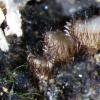


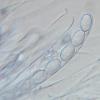
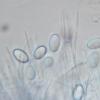

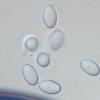
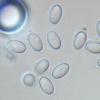
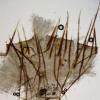






 Gamundi, I.J. (1973) - Discomycetes de Tierra del Fuego II. Especies nuevas de Humariaceae.
Gamundi, I.J. (1973) - Discomycetes de Tierra del Fuego II. Especies nuevas de Humariaceae.